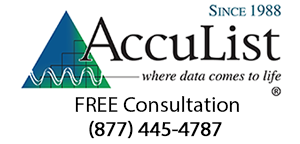How Can Performing Arts Marketing Find the Best Targets?
Since AccuList USA has successfully worked with performing arts and cultural organizations in audience development, supplying data and data services to help them acquire new patrons, ticket buyers and supporters, we were happy to see a recent npENGAGE.com post underscoring the key role of quality data targeting in performing arts marketing success.
Identify & Understand the Best Audience
Basically, performing arts marketers must acquire prospects with the potential to become long-term, high-value patrons; retain them; and maximize their dollar contributions. That challenge is not easy when studies show 72% of single-ticket buyers do not return, points out npENGAGE article author Chuck Turner, a senior analytics specialist at the Target Analytics agency for arts and cultural clients. So a cost-effective marketing strategy will rely on data analytics both to target those with the highest relationship potential and to personalize messaging and offers for boosted ROI and loyalty.
Target to Increase Revenue & Donations
Analysis should look at the value of patrons in terms of the average of all revenue earned, including things such as gift shop and concession sales and tuition for classes offered, as well as ticket sales and subscriptions, Turner urges. That means targeting likely high-revenue prospects, plus, since it’s easier to increase revenue from existing patrons than to acquire new ones, targeting the right members of the audience pool for offers of add-ons and upgrades. For both groups, Turner suggests selecting those with higher average income, and thus higher capacity to spend. According to the Bureau of Labor Statistics, the average high-income person spends over $8,200 on entertainment each year, so if average program revenue per attendee is $34.33 (the average performing arts program revenue per attendee in 2013), there’s room to grab a bigger share! When it comes to increasing donations, external list data on both discretionary spending ability and nonprofit donation history can be used to target significant nonprofit donor prospects for acquisition, and that data can be appended to the existing audience database to better target for add-ons and upgrades. Turner points to Target Analytics findings that, on average, up to 40% of nonprofit audiences can be top prospects for significant contributory giving–if you communicate to prospects with a message that resonates with their mission-based interest.
Segment to Maximize Lifetime Value
With limited resources, performing arts marketers need to be more strategic and proactive in focusing on the most valuable segments. This means tracking lifetime value, defined as the net profit attributed to the entire future relationship discounted to its current value. Again, quality data can help target the right people–those with high lifetime value–with the right message. For both audience database and prospecting mailing lists, Turner stresses selecting targets based on charitable giving and income/discretionary spending ability. Conversely, knowing those unlikely to donate or spend helps minimize investment in unprofitable segments. For more, see https://npengage.com/nonprofit-fundraising/arts-fundraising-and-analytics/
Focus on E-mail Data for 2018 Insurance Marketing Success
Success with e-mail in 2018 insurance marketing boils down to using quality, targeted data–something that AccuList USA is committed to delivering. Data provider V12Data summed it up well in a recent post offering basic insurance e-mail data tips.
Start With Clean, Up-to-Date Data
With an estimated 30% of e-mail subscribers changing their addresses each year, make sure all e-mail lists are up-to-date, with addresses validated and verified, including any e-mail addresses that have been matched and appended to a postal list. Good list hygiene should include removing duplicates; correcting formatting errors; identifying addresses known to be associated with spam traps; and eliminating hard bounces, invalid e-mails/domains, and e-mails associated with complaints.
Profile, Segment and Personalize
There’s no point to all that quality e-mail data if it’s not used to understand and target your audience. That means looking at both actionable internal data, such as customer service records, transactions, credit card purchases or e-mail responses as well as relevant demographic data, either from first-party collection or appended via third-party data aggregators. Consumer demographics could include date of birth, home ownership, occupation, gender, estimated income, age, presence of children, investments and more. Then segment your lists in order to offer the right product to the right audience segment. Plus use data to personalize offers and creative, and that means going beyond a Dear FirstName. Today’s e-mail audience expects and demands personalized offers.
Pay Attention to Buying Cycle and Life Cycle
Smart e-mail campaigns nurture customers and prospects through the buying cycle. Because those who request general information and those who fill out a request for quote form may be at different stages of the buying cycle, they need different messaging. Website signups can be sent a personalized welcome message, while subscribers who have not taken further action can get a follow-up nurturing message about products and services, with a call-to-action promoting a free quote or agent call. When a prospect makes a quote request, e-mail messaging can focus on getting to a policy sale, with more policy information and a specific offer or promotion. Note that life cycle counts as much as buying cycle. Consumers are more likely to buy insurance during major life-event changes, such as marriage, divorce, moving, home purchase, a new baby, retirement, etc. Leveraging that data in targeting sends the right offer at the right time for maximum response.
Check out AccuList USA’s insurance marketing data expertise and clients on our website.
2018 USPS Rate Hikes Challenge Direct Marketers
On January 21, the U.S. Postal Service bumped up its rates for almost all mailings by direct marketers and publishers: Marketing Mail (formerly Standard Mail), First Class Mail Retail, First Class Mail Discount and Periodicals. Most of the increases are small, but volume mailers among Acculist USA’s direct marketing clients could feel the pinch. What are some of the strategies to offset the effect on marketing budgets?
Look for Savings Opportunities!
Before panicking, mail marketers need to check out the whole USPS rate change grid. A 1% to 2% overall increase will be higher or lower depending on the class, weight, zone, density and special services required, and there are actually some savings to be had. For example, while the First Class stamp is going from $0.49 to $0.50 for a 1-ounce letter, a 2% bump, the USPS did not increase the additional ounce rate, so the percentage change gets smaller as items get larger. Meanwhile, metered letters are increasing from $.46 to $.47 in postage, which offers a significant savings of $0.03 per piece for those using a postage meter or PC postage, points out a recent Mailing Systems Technology post. Although most USPS discounts are tied to doing more work, such as barcoding or sorting, this metered rate savings is automatic for just using a system to print postage that costs as little as $20 per month, the article notes.
Even More Value for Presorting, Package Changes
There are other savings to be had via presorting, adds the Mailing Systems Technology article. For example, last year the USPS increased the weight limit for letter rates from 2 ounces to 3.5 ounces. Now, with the rate for a 3-ounce metered letter at $0.89 and a commercial rate of $0.378, there’s a potential 58% savings from using presort services. Package changes can help the budget, too. Folding a flat (9×12 or 10×13) package into a 6×9 envelope could mean significant savings with the new rates. A three-ounce flat at $1.42 now could cost as little as $0.378 if it can be put in an envelope and automated through in-house software or presort services. Plus, mailers sending Priority Mail items at retail rates using Click-N-Ship or a postage meter can switch to a PC Postage solution using commercial rates to save 10% overall, or 2% to 40% less based on weight and zone.
Importance of Targeted, Quality Data Underscored
As data brokers, AccuList USA stresses that these postal cost changes also should push marketers to use data-driven direct mail in more strategic and creative multi-channel campaigns. To maximize mailing ROI, marketers should cut wasted mail by improving targeting, mailing list selection, and data/address quality, as well as apply response-boosting creative tactics, such as personalization and special printing effects.
For rate tables and more advice on the USPS rate hikes, see the Mailing Systems Technology post.



